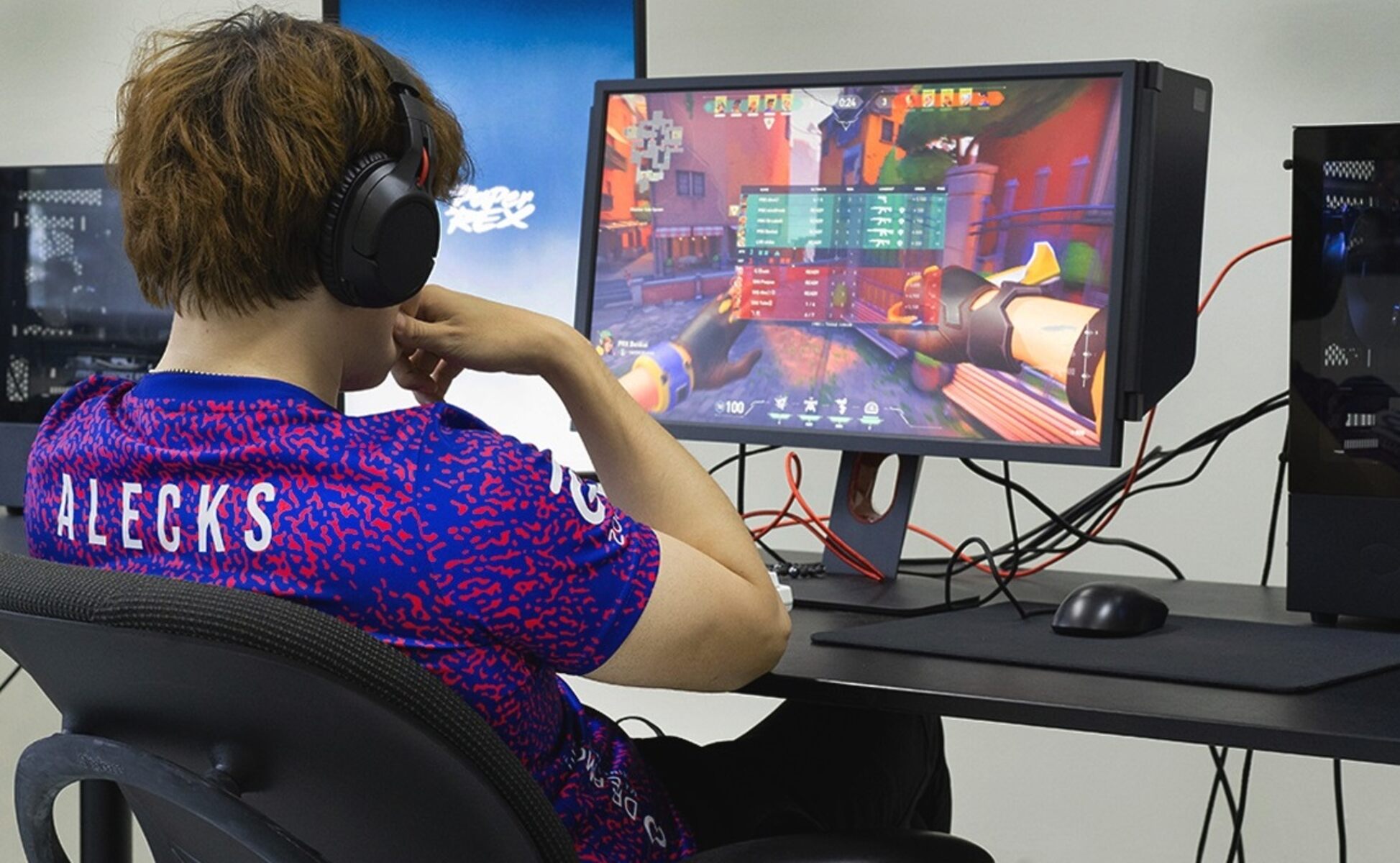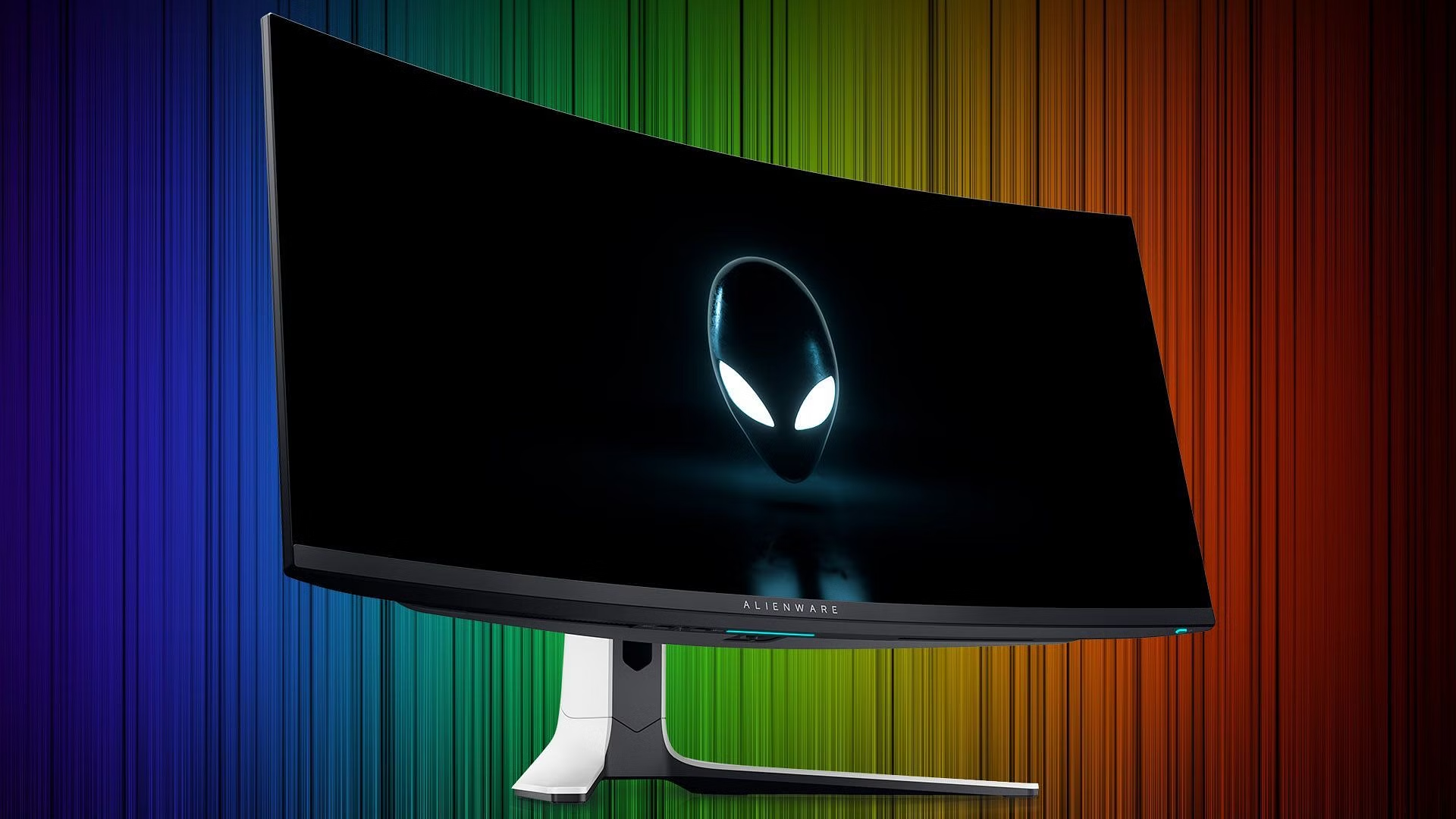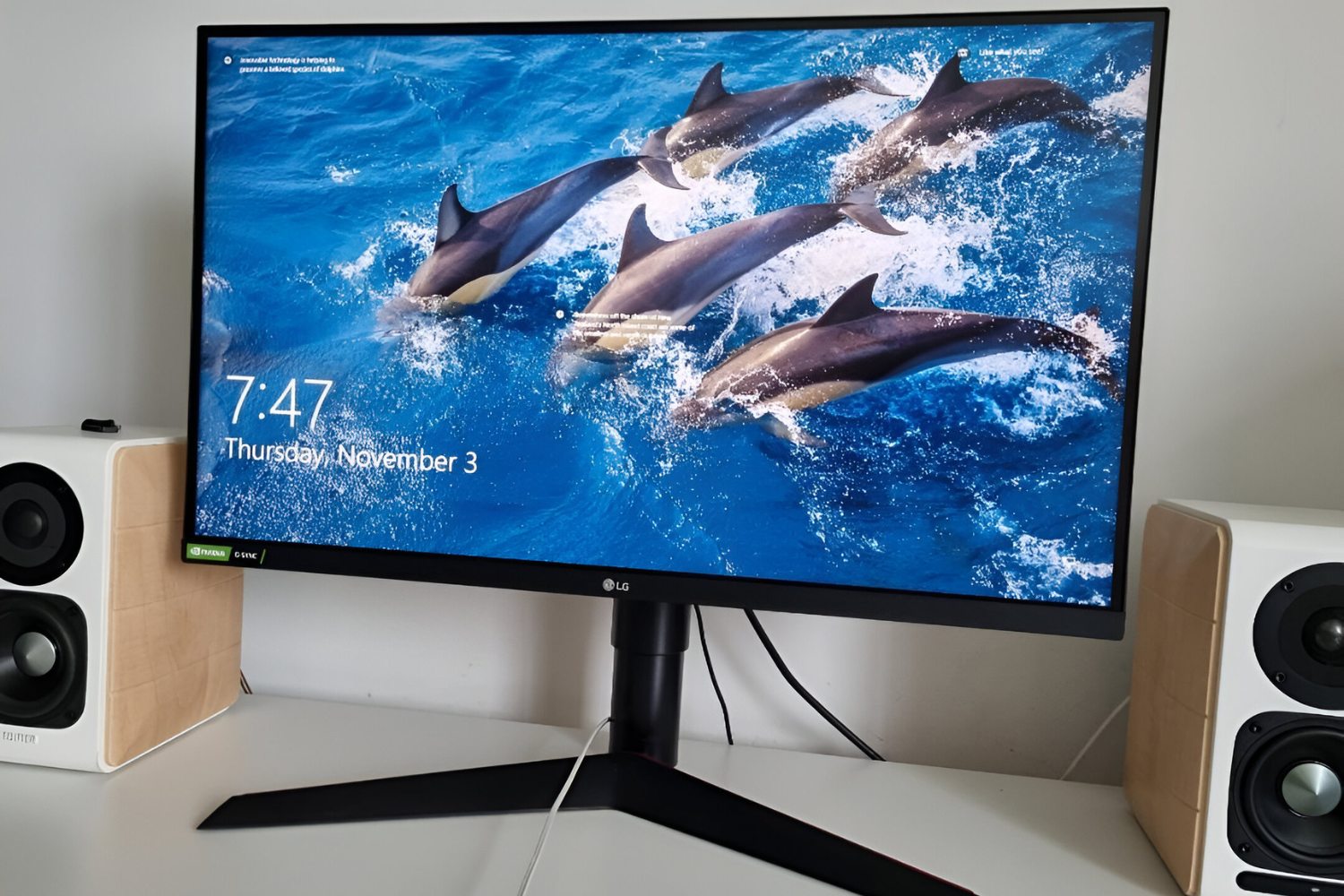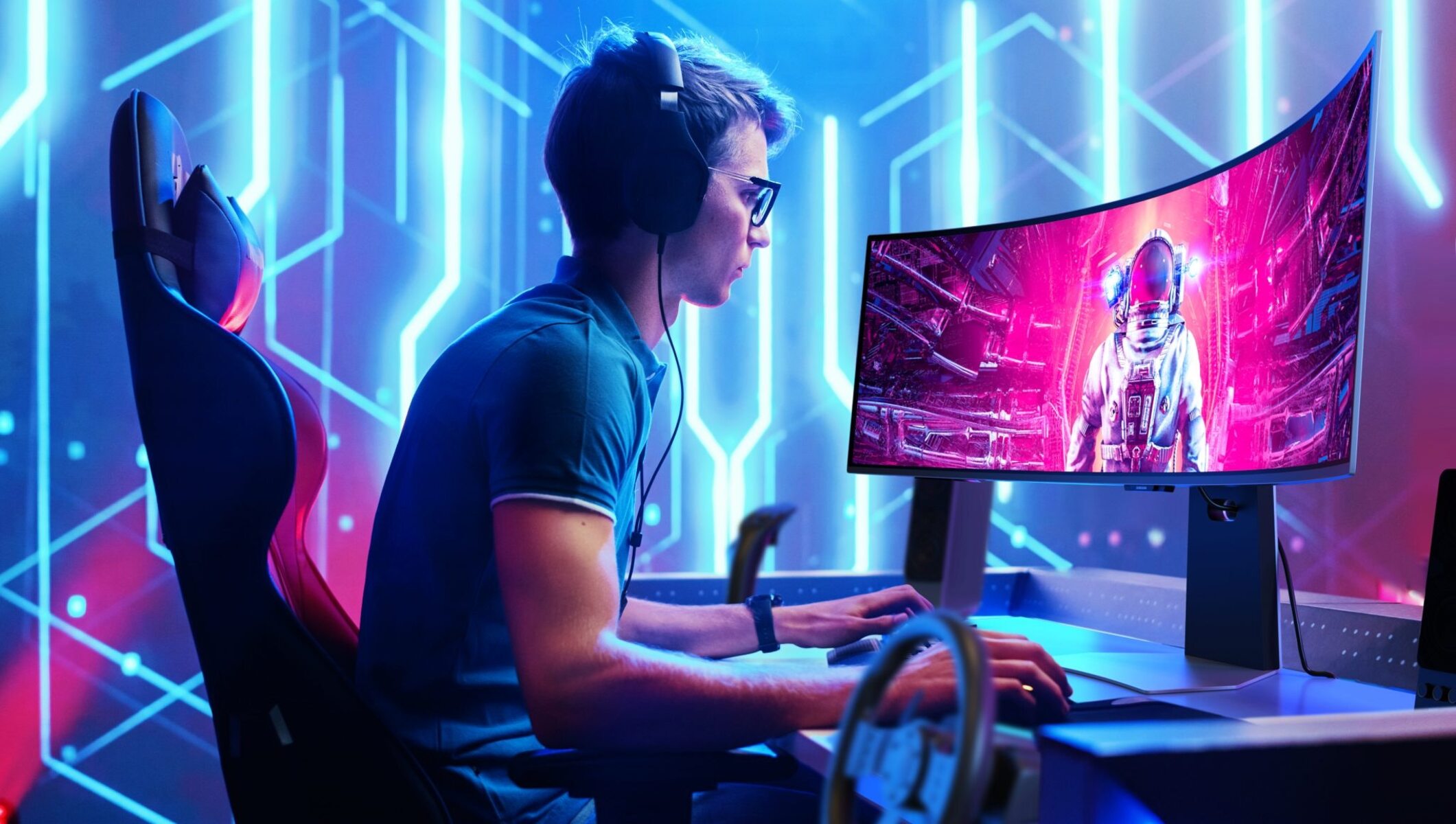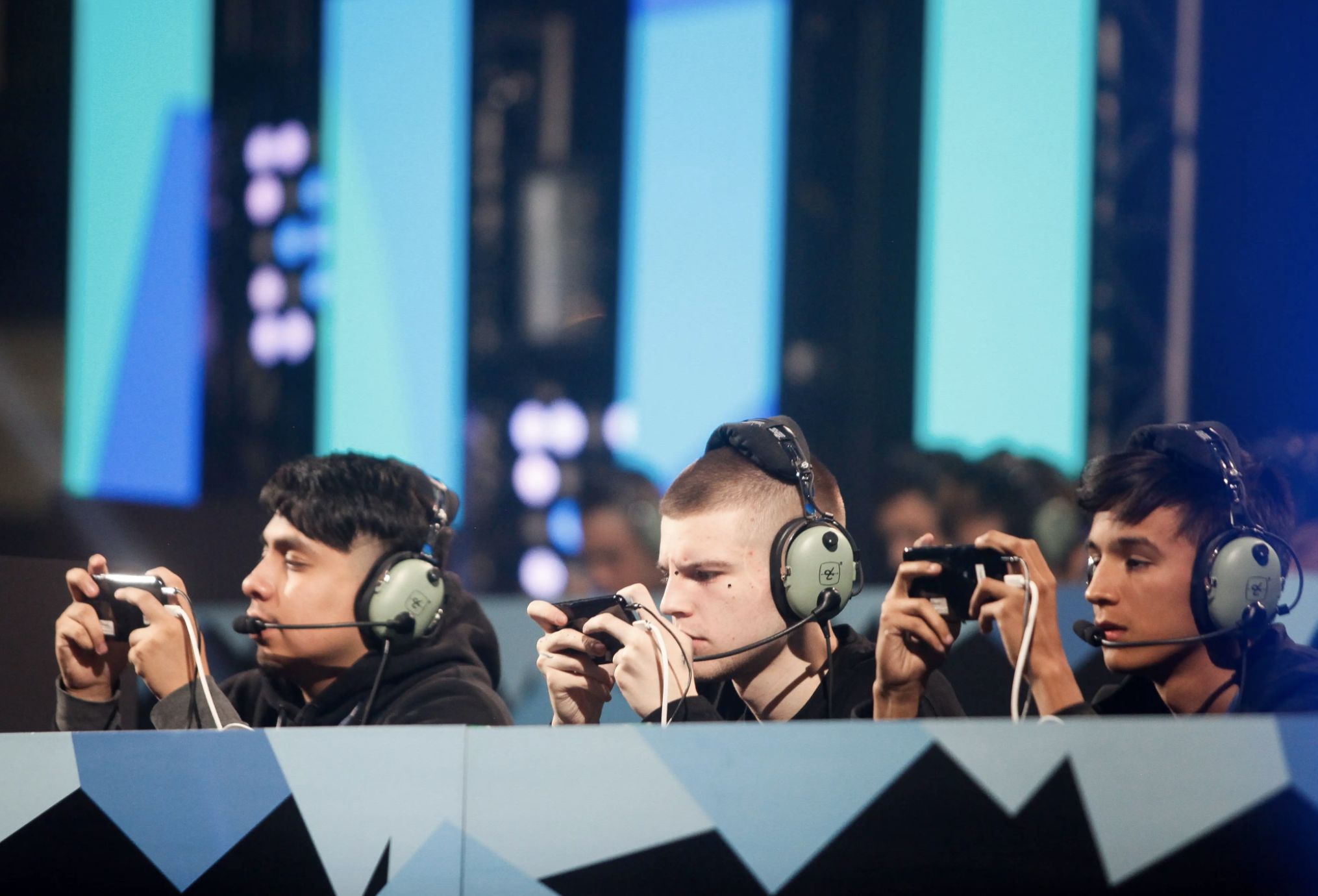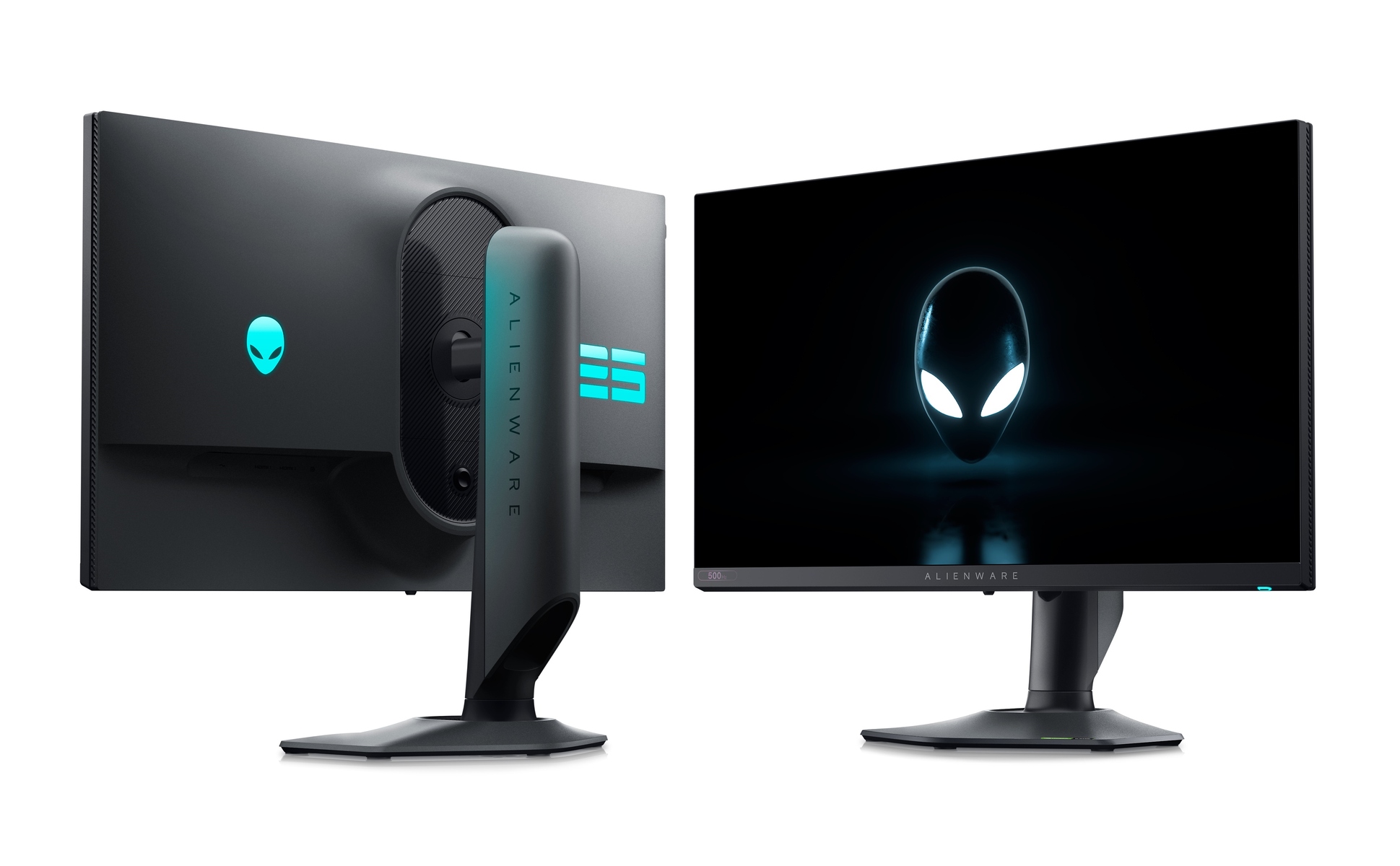Introduction
Welcome to the world of esports, where top gamers compete at the highest level in various competitive video games. As the esports industry continues to grow in popularity, the equipment used by professional players becomes increasingly important. One crucial piece of equipment that greatly impacts a player’s performance is the gaming monitor.
The gaming monitor serves as the window to the digital battlefield, providing players with visual feedback and responsiveness that can make all the difference between victory and defeat. It plays a vital role in delivering a seamless gaming experience, ensuring that players can react swiftly, accurately, and with precision.
In today’s competitive esports landscape, choosing the right gaming monitor has become a crucial decision for professional players and gaming enthusiasts alike. With a wide range of options available on the market, it’s essential to understand the features and factors that contribute to an optimal gaming experience.
In this article, we will explore the significance of gaming monitors in esports. We will delve into the factors that players and teams consider when selecting a gaming monitor, and we will highlight some popular models that are commonly used in the esports community. Whether you’re a professional esports athlete or a passionate gamer, this article will provide you with valuable insights into the world of gaming monitors.
So, let’s dive in and discover the fascinating world of gaming monitors in the thrilling realm of esports!
Overview of Esports Industry
The esports industry has experienced exponential growth in recent years, transforming from a niche hobby into a global phenomenon. Esports, short for electronic sports, refers to competitive video gaming where professional players or teams compete against each other for big prizes and recognition.
What was once seen as a pastime for a select few has now become a multi-billion-dollar industry with a dedicated fanbase that spans the globe. Esports events are held in sold-out arenas, and millions of viewers tune in online to watch their favorite teams battle it out in popular games like League of Legends, Dota 2, Counter-Strike: Global Offensive, and many others.
The popularity of esports can be attributed to several factors. The accessibility of gaming platforms and the rise of online gaming communities have made it easier for players to connect and compete with others around the world. The advancements in technology have also played a significant role, with improved graphics, faster internet speeds, and more immersive gameplay experiences.
Esports has also been embraced by mainstream media, with major sports networks and streaming platforms dedicating coverage to esports events. This increased exposure has attracted sponsorship deals and investments from companies outside the gaming industry, further fueling the growth of the esports market.
One of the key drivers behind the success of the esports industry is the passionate and dedicated fanbase. Esports events attract fans of all ages, who follow their favorite teams and players, attend live tournaments, and engage in online discussions. The sense of community and camaraderie within the esports community is a testament to the power of video games as a form of entertainment and competition.
As the esports industry continues to expand, players and teams are constantly striving to gain a competitive edge. This is where gaming monitors come into play. These high-performance displays are designed to deliver fast response times, smooth motion, and accurate color reproduction, enhancing the gaming experience for players and providing a more immersive viewing experience for spectators.
In the following sections, we will explore the importance of gaming monitors in esports and discuss the factors that players consider when selecting the perfect monitor for their gaming needs. Join us as we dive into the fascinating world of gaming monitors in the realm of esports!
Importance of Gaming Monitors in Esports
Gaming monitors play a crucial role in the success of professional esports players and the overall gaming experience. These specialized displays are designed to provide fast response times, high refresh rates, and superior image quality, ensuring that players can react quickly and accurately in fast-paced games. Here are some reasons why gaming monitors are so important in the world of esports:
1. Responsiveness: In competitive gaming, every millisecond counts. Gaming monitors with low input lag and high refresh rates ensure that the actions performed by players are displayed on the screen almost instantly. This translates to a more responsive and immersive gaming experience, allowing players to execute their moves with precision and accuracy.
2. Smooth Gameplay: High refresh rates, usually measured in hertz (Hz), offer smoother motion on the screen. This is particularly important in fast-paced esports titles where quick movements and split-second reactions are crucial. Higher refresh rates reduce motion blur, making it easier for players to track fast-moving objects and enemies, ultimately improving their performance.
3. Visual Clarity: Gaming monitors with high-resolution displays offer crisp and clear visuals, allowing players to see details with greater clarity. This can make a significant difference in games where spotting enemies or identifying objects at a distance is essential. The enhanced visual clarity provided by gaming monitors can give players a competitive edge in esports competitions.
4. Color Accuracy: Accurate color reproduction is important in gaming, as it ensures that players see the game world as intended by the developers. Gaming monitors with high color accuracy provide vibrant and true-to-life colors, enhancing the overall visual experience. This is especially important in esports titles where different colors may represent important gameplay elements.
5. Eye Comfort: Professional esports players often spend long hours practicing and competing. Gaming monitors with features such as flicker-free technology and blue light filters help reduce eye strain and fatigue, allowing players to perform at their best for extended periods without compromising their comfort.
Gaming monitors are not only essential for professional esports players but also for casual gamers who seek an immersive and enjoyable gaming experience. The advancements in monitor technology continue to push the boundaries of what is possible, providing gamers with an edge and enriching their overall gaming experience.
In the next section, we will explore the factors that players consider when choosing a gaming monitor for esports competitions. Stay tuned!
Factors to Consider When Choosing a Gaming Monitor for Esports
Choosing the right gaming monitor for esports is a critical decision that can significantly impact a player’s performance. With a plethora of options available on the market, it’s important to consider several factors before making a purchase. Here are some key factors to consider when selecting a gaming monitor for esports:
1. Refresh Rate: The refresh rate refers to the number of times the monitor updates the image per second, measured in hertz (Hz). Higher refresh rates, such as 144Hz or 240Hz, provide smoother and more fluid motion on the screen. This can greatly enhance the gaming experience, particularly in fast-paced games where quick reactions are crucial.
2. Response Time: The response time of a monitor determines how quickly it can change from one color to another. A lower response time, measured in milliseconds (ms), means faster pixel transitions and reduces motion blur. This is especially important in competitive esports titles where fast-moving objects require swift and accurate tracking.
3. Input Lag: Input lag refers to the delay between a player’s action and the corresponding movement on the screen. Low input lag is crucial for achieving optimal responsiveness. Look for gaming monitors with low input lag to ensure that your actions are displayed on the screen as quickly as possible.
4. Display Technology: There are various display technologies available, such as TN (twisted nematic), IPS (in-plane switching), and VA (vertical alignment). Each has its own strengths and weaknesses. TN panels offer faster response times but narrower viewing angles, while IPS panels provide better color accuracy and wider viewing angles. Consider your preferences and gaming needs when choosing the right display technology.
5. Resolution: The resolution of a gaming monitor determines the number of pixels and the level of detail that can be displayed. Higher resolutions, such as 1080p (Full HD), 1440p (Quad HD), or 4K, offer sharper images and more immersive visuals. However, keep in mind that higher resolutions require more powerful hardware to run games smoothly.
6. Size: The size of the gaming monitor is a matter of personal preference and gaming setup. Larger monitors can provide a more immersive experience, but they require more desk space. Consider the size of your gaming area and choose a monitor that fits comfortably within your setup.
7. Budget: Set a budget for your gaming monitor and consider the features that are most important to you. While top-of-the-line monitors may offer the best performance, there are also affordable options that provide excellent value for money.
By considering these factors, you can make an informed decision when choosing a gaming monitor for esports. Each player has unique preferences, so it’s important to find the monitor that best suits your gaming style and needs.
In the following sections, we will explore some popular gaming monitors used in the esports community. Stay tuned for more insights into the world of gaming monitors in esports!
Popular Gaming Monitors Used in Esports
When it comes to professional esports competitions, players and teams often rely on gaming monitors that offer top-notch performance and cutting-edge features. While the choice of gaming monitor may vary depending on personal preferences and game genres, there are several models that have gained popularity and recognition within the esports community. Here are some popular gaming monitors used in esports:
1. ASUS ROG Swift PG258Q: This 24.5-inch gaming monitor offers a blazing-fast 240Hz refresh rate and a 1ms response time, ensuring ultra-smooth motion and minimal input lag. It features Full HD resolution and NVIDIA G-SYNC technology for tear-free and stutter-free gameplay. The ASUS ROG Swift PG258Q is frequently chosen by professional esports players for its exceptional performance in fast-paced games.
2. BenQ Zowie XL2546: Designed specifically for esports, the BenQ Zowie XL2546 is a 24.5-inch gaming monitor with a 240Hz refresh rate and a 1ms response time. Its signature feature is the Dynamic Accuracy technology, which reduces motion blur and provides clearer movement. The monitor also includes customizable display settings and features to optimize gameplay, making it a popular choice among professional players.
3. Acer Predator XB271HU: The Acer Predator XB271HU is a 27-inch gaming monitor that boasts a 1440p resolution and IPS panel technology. It offers a high 165Hz refresh rate and a 4ms response time, delivering smooth gameplay and vibrant visuals. With NVIDIA G-SYNC support, this monitor provides tear-free gaming performance, making it a favorite among esports players who value both image quality and performance.
4. Alienware AW2518H: The Alienware AW2518H is a 25-inch gaming monitor that excels in fast-paced gaming environments. It features a 240Hz refresh rate, a 1ms response time, and NVIDIA G-SYNC compatibility. With its sleek design and customizable lighting effects, it not only delivers exceptional performance but also looks great in any gaming setup.
5. ASUS TUF Gaming VG279QM: The ASUS TUF Gaming VG279QM is a 27-inch gaming monitor with a 280Hz refresh rate, making it one of the fastest monitors available. It has an IPS panel for accurate colors and wide viewing angles. It also features ELMB Sync (Extreme Low Motion Blur Sync) technology, which further reduces motion blur for a clearer gaming experience. The ASUS TUF Gaming VG279QM is a popular choice among competitive gamers seeking high-speed performance.
These are just a few examples of the popular gaming monitors commonly used in esports. Each of these monitors offers unique features and specifications that cater to the demands of professional players, ensuring a competitive edge in intense gaming scenarios.
It’s important to note that the choice of a gaming monitor ultimately depends on individual preferences, gaming needs, and budget. Players should consider factors such as refresh rate, response time, display technology, resolution, and size when making their selection.
In the next sections, we will explore additional features that players consider when choosing gaming monitors for esports, such as high refresh rates, low input lag, adaptive sync technology, and panel types. Stay tuned for more insights!
High Refresh Rate Monitors
In the fast-paced world of esports, having a high refresh rate monitor is essential for a competitive edge. Refresh rate refers to the number of times per second that a monitor updates the image it displays. The higher the refresh rate, the smoother and more fluid the motion appears on the screen. Here’s why high refresh rate monitors are favored in esports:
1. Smoother Gameplay: A higher refresh rate, usually measured in hertz (Hz), allows for more frames to be displayed per second. This results in smoother gameplay, providing players with a more immersive experience and making it easier to track fast-moving objects, react quickly, and make precise movements.
2. Reduced Motion Blur: High refresh rate monitors significantly reduce motion blur, resulting in clearer images during fast-paced gameplay. By updating the screen more frequently, these monitors minimize the time it takes for each frame to update, ensuring smoother transitions and diminishing the blurring effect that can hinder visibility and reaction times.
3. Enhanced Responsiveness: High refresh rate monitors offer improved responsiveness, especially when paired with low input lag and fast response times. The combination of these factors ensures that actions taken by players are displayed on-screen quickly, allowing for more instantaneous feedback and reducing the delay between the player’s input and the on-screen representation.
4. Competitive Advantage: In esports, every advantage matters. A high refresh rate monitor can give players a competitive edge, allowing them to spot and react to movements and actions faster than their opponents. This heightened responsiveness can be the difference between landing critical shots, escaping dangerous situations, or executing complex strategies successfully.
5. Future-Proof Investment: As gaming technology continues to advance, high refresh rate monitors are becoming increasingly common. Investing in a high refresh rate monitor ensures that you’ll be able to fully take advantage of upcoming game and hardware developments. It also allows for a more immersive and enjoyable gaming experience, not only in esports but also for a wide range of other games.
Many high refresh rate monitors on the market offer refresh rates of 144Hz, 240Hz, or even higher. While higher refresh rates can provide smoother gameplay, it’s important to note that the benefits are most notable in fast-paced games that can consistently achieve high framerates.
It’s also worth considering the hardware requirements necessary to run games at high refresh rates. To fully utilize a high refresh rate monitor, you’ll need a capable graphics card and a powerful CPU to deliver the necessary frames per second. However, even if you can’t reach the full potential of a high refresh rate monitor immediately, investing in one can ensure that you’ll benefit as your hardware and gaming library evolve.
In the following sections, we will explore other important features to consider when choosing a gaming monitor for esports, such as low input lag, adaptive sync technology, panel types, and resolution. Stay tuned for more insights!
Low Input Lag Monitors
When it comes to competitive gaming, having low input lag is paramount. Input lag refers to the delay between a player’s action, such as pressing a key or moving the mouse, and the corresponding display of that action on the screen. In esports, where split-second reactions can be the difference between victory and defeat, choosing a monitor with low input lag is crucial. Here’s why low input lag monitors are favored in esports:
1. Faster Response Time: Monitors with low input lag offer faster response times, which means that the actions performed by players are displayed on the screen with minimal delay. This allows for more accurate and timely visual feedback, enabling players to react swiftly and precisely to in-game events.
2. Improved Responsiveness: Low input lag creates a more responsive gaming experience, as the time between a player’s input and the resulting action on-screen is significantly reduced. This instantaneous feedback translates to better control and accuracy, enhancing the overall gameplay performance.
3. Enhanced Competitive Advantage: In esports competitions, where every millisecond matters, low input lag can provide a competitive edge. It allows players to execute actions more swiftly, giving them a slight advantage over opponents who may be using monitors with higher input lag.
4. Accurate Representation: Low input lag ensures that what players see on the screen closely aligns with the real-time events happening within the game. This accuracy is crucial for precise aiming, executing complex strategies, and making split-second decisions, ultimately leading to better gameplay performance.
5. Seamless Gaming Experience: A low input lag monitor offers a more seamless and immersive gaming experience. There is a noticeable reduction in the delay between input and display, creating a smoother interaction between players and the game. This enhanced responsiveness can result in increased enjoyment and immersion during gameplay sessions.
It’s important to note that input lag can be affected by various factors, including the monitor’s internal processing, the connection type (e.g., HDMI, DisplayPort), and the player’s computer hardware. To achieve the lowest input lag possible, it’s recommended to use gaming monitors specifically designed for fast response times and optimize other factors within the gaming setup, such as using a direct connection rather than adapters.
When shopping for a gaming monitor, it’s vital to check the manufacturer’s specifications for input lag, as it is not always prominently displayed. Additionally, consider reading reviews and seeking recommendations from other gamers, particularly those in the esports community, to ensure that your chosen monitor provides the low input lag required for competitive gaming.
In the next sections, we will explore additional features to consider when choosing a gaming monitor for esports, including adaptive sync technology, panel types, and resolution. Stay tuned for more insights and guidance on selecting the perfect gaming monitor to enhance your esports experience!
Adaptive Sync Monitors
In the world of esports, having a smooth and tear-free gaming experience is crucial. This is where adaptive sync technology comes into play. Adaptive sync monitors, such as AMD FreeSync or NVIDIA G-SYNC compatible displays, are designed to eliminate screen tearing and provide a more fluid and immersive gameplay experience. Here’s why adaptive sync monitors are favored in esports:
1. Tear-Free Gaming: Adaptive sync technology synchronizes the refresh rate of the monitor with the frame rate of the graphics card, ensuring that the two are perfectly aligned. This eliminates screen tearing, a visual artifact that occurs when the monitor displays two or more frames at the same time, creating a disjointed picture. By preventing screen tearing, adaptive sync monitors provide a smooth and tear-free gaming experience, giving players clearer visuals and reducing distractions.
2. Enhanced Visuals: Adaptive sync technology also addresses another issue called stuttering or micro-stuttering. Stuttering occurs when the graphics card and monitor are not perfectly synchronized, causing irregular frame delivery and inconsistent frame times. Adaptive sync technology helps to reduce these visual imperfections, resulting in smoother and more visually pleasing gameplay. This is particularly important in esports, where fluid motion and clear visuals contribute to better performance.
3. Improved Responsiveness: While adaptive sync focuses primarily on eliminating screen tearing and stuttering, it indirectly contributes to improved responsiveness. By providing a more fluid and consistent visual experience, adaptive sync monitors allow players to perceive the game world more accurately and react faster to in-game events. This can lead to quicker reflexes, better aim, and overall improved gameplay performance.
4. Wider Compatibility: Adaptive sync technology is supported by both AMD and NVIDIA graphics cards, ensuring compatibility with a wide range of hardware configurations. This means that regardless of whether you have an AMD or NVIDIA graphics card, you’ll have the option to choose from a variety of adaptive sync monitors to enhance your gaming experience.
5. Future-Proof Investment: As technology evolves, adaptive sync monitors continue to improve and become more prevalent. Investing in an adaptive sync monitor ensures that you can take full advantage of the technology’s benefits now and in the future. As new games and hardware advancements emerge, having an adaptive sync monitor will allow you to enjoy tear-free and smooth gaming experiences across a wide range of titles.
It’s worth noting that while adaptive sync technology provides significant benefits, the specific implementation may vary between monitors. AMD FreeSync works with compatible AMD graphics cards, while NVIDIA G-SYNC is designed for NVIDIA graphics cards. However, some adaptive sync monitors can support both technologies, offering more flexibility when it comes to hardware compatibility.
When choosing an adaptive sync monitor, consider factors such as the monitor’s refresh rate, response time, resolution, and other features that are important to you as a gamer. By selecting a monitor that combines adaptive sync technology with other desirable attributes, you can optimize your esports gaming experience.
In the following sections, we will explore additional features to consider when choosing a gaming monitor for esports, including panel types, resolution, and other essential considerations. Stay tuned for more insights and guidance!
Resolution and Size of Gaming Monitors in Esports
When it comes to gaming monitors in esports, the choice of resolution and size plays a significant role in determining the overall gaming experience. The resolution refers to the number of pixels displayed on the screen, while the size relates to the physical dimensions of the monitor. Here’s why resolution and size are crucial considerations for gaming monitors in esports:
1. Resolution: The resolution of a gaming monitor directly impacts the level of detail and clarity in the displayed image. Higher resolutions, such as 1080p (Full HD), 1440p (Quad HD), or 4K, provide sharper and more detailed visuals. This can be advantageous in esports, where spotting enemies, reading text, and distinguishing small details are often crucial. However, keep in mind that higher resolutions require more powerful hardware to achieve smooth framerates in demanding games.
2. Size: The size of a gaming monitor affects both the viewing experience and the available desk space. A larger monitor can provide a more immersive experience, as the game’s details are more prominently displayed. However, it’s essential to consider the ergonomics of your gaming setup and ensure that the monitor size doesn’t hinder your ability to comfortably view the entire screen or strain your neck and eyes.
3. Immersion: A larger monitor, combined with an appropriate viewing distance, can create a more immersive gaming experience. The increased field of view allows for a broader perspective in games, enhancing situational awareness and making it easier to spot enemies or important in-game elements. This can be particularly beneficial in esports titles that require quick decision-making and precise positioning.
4. Performance: Higher resolutions demand more from your computer’s hardware to maintain smooth framerates, which can be especially challenging in competitive esports titles that prioritize fast and fluid gameplay. It’s crucial to strike a balance between resolution and performance based on your hardware capabilities to ensure a consistently smooth gaming experience.
5. Desk Space: The physical size of the gaming monitor also needs to be considered in relation to your desk space. While larger monitors offer a more immersive experience, they require more desk real estate. It’s essential to measure your available space and ensure that the chosen monitor can comfortably fit within your gaming setup without overcrowding or causing inconvenience.
Ultimately, the choice of resolution and size depends on personal preferences, gaming needs, and hardware capabilities. Consider factors such as the viewing distance, level of detail desired, and available desk space to make an informed decision when selecting a gaming monitor for esports.
It’s worth mentioning that some larger monitors may have lower pixel density at the same resolution compared to smaller monitors. This can result in slightly less sharp or pixelated visuals. However, this may not be a significant concern for gamers who prioritize a larger field of view and immersive experience over pixel-perfect image clarity.
In the next sections, we will explore other important features to consider when choosing a gaming monitor for esports, such as panel types, ergonomics, and additional functionalities. Stay tuned for more insights to help you make the best decision for your esports gaming setup!
Panel Types Used in Gaming Monitors for Esports
When it comes to gaming monitors in esports, the choice of panel type can significantly impact the visual quality, color accuracy, and viewing experience. Different panel technologies offer distinct advantages and disadvantages, making it important to consider the panel type when selecting a gaming monitor. Here are the most common panel types used in gaming monitors for esports:
1. Twisted Nematic (TN) Panels: TN panels are known for their fast response times, making them ideal for competitive gaming. They offer excellent motion clarity, reducing ghosting and blurring during fast-paced gameplay. TN panels typically have lower input lag, providing quick and responsive visuals. However, compared to other panel types, TN panels generally offer narrower viewing angles and poorer color accuracy.
2. In-Plane Switching (IPS) Panels: IPS panels provide better color reproduction and wider viewing angles compared to TN panels. They offer more accurate and vibrant colors, making them suitable for gamers who prioritize visual quality. IPS panels provide good image clarity and a more immersive viewing experience. However, they typically have slower response times compared to TN panels, which can result in slightly more motion blur in fast-paced games.
3. Vertical Alignment (VA) Panels: VA panels strike a balance between TN and IPS panels. They offer better contrast ratios, deeper blacks, and improved color reproduction compared to TN panels. VA panels typically have faster response times compared to IPS panels, making them suitable for gaming. However, they may exhibit slight motion blur in fast-paced scenes. VA panels also have wider viewing angles compared to TN panels but slightly narrower angles compared to IPS panels.
Each panel type has its own strengths and weaknesses, so the choice ultimately depends on personal preferences and gaming needs. For competitive esports gaming, TN panels tend to be favored due to their fast response times and low input lag, which are essential for quick reactions and precise movements. The smoother motion and better color accuracy of IPS and VA panels can be appealing for those who prioritize a more immersive gaming experience or enjoy visually stunning games.
It’s important to note that there can be variations in the quality and performance of panels within each type, so it’s advisable to read reviews and consider factors such as color accuracy, response time, and input lag specific to the model you are interested in. Additionally, advances in panel technology continue to address some of the drawbacks associated with each panel type.
When selecting a gaming monitor for esports, consider your desired balance between response time, color accuracy, viewing angles, and overall visual quality. Taking into account your gameplay preferences and budget, you can make an informed decision on the panel type that best suits your needs and enhances your esports gaming experience.
In the next sections, we will explore other important features and considerations when choosing a gaming monitor for esports, such as ergonomic design, connectivity options, and additional functionalities. Stay tuned for more insights to help you make the best choice!
Conclusion
Gaming monitors are a vital component in the world of esports, impacting the performance and overall gaming experience of professional players and gaming enthusiasts alike. We have explored various aspects of gaming monitors in esports, from their importance and factors to consider when choosing one to popular models used by professional players. Let’s recap the key takeaways:
1. Gaming monitors play a critical role in providing responsiveness, smooth gameplay, and visual clarity, all essential for success in esports competitions.
2. Factors to consider when choosing a gaming monitor include refresh rate, response time, input lag, display technology, resolution, size, and budget.
3. Popular gaming monitors used in esports include models like ASUS ROG Swift PG258Q, BenQ Zowie XL2546, Acer Predator XB271HU, Alienware AW2518H, and ASUS TUF Gaming VG279QM.
4. High refresh rate monitors offer smoother gameplay, reduced motion blur, and improved responsiveness.
5. Low input lag monitors provide faster response times and enhance the overall gaming experience.
6. Adaptive sync monitors, such as AMD FreeSync and NVIDIA G-SYNC compatible displays, eliminate screen tearing and provide a tear-free gaming experience.
7. The choice of resolution and size depends on personal preferences, hardware capabilities, and the desired level of immersion and visual detail.
8. Different panel types, including TN, IPS, and VA panels, offer unique advantages in terms of response time, color accuracy, and viewing angles.
Remember, selecting the right gaming monitor for esports is a personal choice that depends on individual preferences and specific gaming needs. It’s crucial to consider the factors discussed and evaluate how they align with your gaming style, hardware capabilities, and budget.
By making an informed decision, you can enhance your esports gaming experience and gain a competitive edge in the exciting world of professional gaming. Keep abreast of the latest advancements in gaming monitor technology and monitor the recommendations of professional players, as the esports industry continues to evolve, and new innovations emerge.
Now that you have a better understanding of gaming monitors in the realm of esports, it’s time to select the perfect monitor that will unlock your true gaming potential. Get ready to immerse yourself in the exhilarating world of esports and conquer the digital battlefield with the right gaming monitor by your side!







